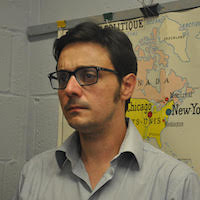
This post is part of the series 5 Questions with COVID Researchers. Hear from researchers across the Northeast United States about how they are working to mitigate the widespread impacts of COVID-19, and learn about opportunities for cross-disciplinary and cross-sector collaboration that could enable further progress in the fight against the pandemic. To learn more about COVID-related research, keep updated with virtual events and funding opportunities, and access other resources including datasets and guides, visit the COVID Information Commons. If you would like to be featured in this series, please email Katie Naum and Helen Yang.
Guest post by Dr. Maurizio Porfiri, Institute Professor at New York University Tandon School of Engineering, and Principal Investigator on NSF Award #2027990 “Agent-based Modeling Toward Effective Testing and Contact-tracing During the COVID-19 Pandemic.”
What is the problem you are trying to solve, and how will you and your team address it?
We are developing a modeling platform to simulate the spread of COVID-19. Our platform consists of two elements: an agent-based model and a geolocalized socio-demographic database of New Rochelle, NY—the town with one of the first COVID-19 outbreaks in the US. Our approach allows for the simulation of each individual in the town and concurrent disease spreading through interactions at schools, at workplaces, and throughout the community. We have a detailed transmission model that specifically focuses on the availability of testing strategies and their effect on the containment and spread of COVID-19, which is amenable to the systematic exploration of a wide range of important “what-if” scenarios.
What data are you working with? How will it be used?
We are working with a variety of datasets: first, we have created an in-house geolocalized socio-demographic database of the town of New Rochelle in New York State, which is being utilized to locate agents within our agent-based model and generate a realistic population; second, we are using data from census surveys to build a mobility profile people within New Rochelle; and, third, we are working with data from Safegraph, a data company which freely provided critical data for COVID-19-related research, to validate our mobility characteristics.
Is your team seeking collaborators, subject matter experts, or other resources that you’d like to put a call out for?
We are eager to work with health services professionals who can help us formulate timely and realistic what-if scenarios that could inform policy-making as we approach the winter season.
How does this work contribute to the fight against the pandemic?
The platform is intended to support COVID-19-related policy-making by enabling the study of multiple what-if scenarios, grounded in real data. For example, the approach is amenable to demonstrating the role of different testing strategies, the use of PPE, and social distancing.
Where can people learn more about your progress?
The platform will soon be available through GitHub. Scientific publications associated with this work will be posted on our lab website.

Maurizio Porfiri is an Institute Professor in the Department of Mechanical and Aerospace Engineering, the Department of Biomedical Engineering, and the Department of Civil and Urban Engineering at New York University Tandon School of Engineering.
